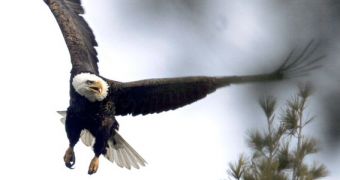Today, only bats, birds and insects can fly. But birds detain the most records of animal flight, from speed to height. Some traits in bird anatomy represent their secret.
1. Feathers evolved first for ensuring a body insulation and maintaining homeothermy (constant body temperature). Feathers can also make a "camouflage coat" and "breeding suit".
Feathers adorn exclusively the birds nowadays. Once, some dinosaurs (from whose group birds evolved) had them as well. The aerodynamic shape of the feathers and their capability to change the shape of the wing in flight led to the perfection of the bird flight. Even if the feathers are considered light, in some cases they can weigh double as compared with the skeleton of the bird. Large birds can have up to 25,000 feathers.
Thanks to the feathers, the birds' wings have amazing freedom degrees during the flight.
2. The birds are more aerodynamic than bats or insects. During the flight, their legs disappear inside the plumage, the same way a plane retreats its landing gear within the lower part of the fuselage.
3. The large bones of the birds do not contain marrow, as they are hollow. They have caverns filled with air sacs that make them extremely light (these are pneumatic bones). The air sacs begin from the lungs and spread throughout the body of the bird, through the muscles, inner organs and inside the bones.
Because of these sacs, the inhaled air passes twice through the lungs, that's why the birds can fly even at heights of 6,600 m (20,000 ft) during their migrations, in an atmosphere poor in oxygen.
4. Being homeothermic, the birds have a high metabolism, and this explains why a hummingbird can execute up to 1,000 wing beats per minute.
5. Birds could turn their fore limbs into wings because their function was taken by the neck. The neck is very flexible, extensible and essential for caring the plumage. While most mammals have 7 cervical (neck) vertebrae, birds have 25.
6. The humerus bone (arm) is very short, thick and strong, inserting the flight muscles connected in both parts of the rib cage.

 14 DAY TRIAL //
14 DAY TRIAL //